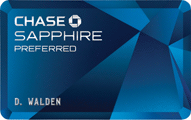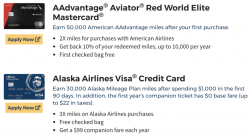The number one question I get from family, friends, and fans is which ONE credit card should they use to get free travel. This is a very important question. While I may have over a dozen cards tailored to specific purposes, most people don’t have the time or interest to fine-tune the ideal rewards card portfolio. There are also very few people interested in actively applying for new cards every few months. Most people want one card for all (or at least most) expenses with a fairly good rewards program.
My answer is simple yet incomplete: Everyone should carry either the Sapphire Preferred card from Chase or the ThankYou Premier Rewards card from Citi. Megan and I continue to use these accounts actively for the majority of our spending.
I said that my answer is incomplete because I still haven’t told you which ONE card you should carry. That comes down to your own personal preferences, both earning and redeeming points. Here I’ll try to break it down so you can decide for yourself. But I will summarize my conclusion now and say that frequent flyers (over 50,000 miles a year) should probably get the Sapphire Preferred. Infrequent flyers should probably get the Citi ThankYou Premier Rewards.
Chase Sapphire Preferred for Frequent Flyers
The Sapphire Preferred earns Ultimate Rewards points, which really are the ultimate reward. These points can be converted into cash-like gift cards (at 1 cent per point), redeemed toward any air ticket (at 1.2 cents per point; and you’ll still earn miles and elite status), or transferred to almost a dozen different loyalty programs including United MileagePlus, British Airways Avios, Hyatt Gold Passport, and Marriott Rewards. Each loyalty program is different, of course, but I personally value my United miles and Hyatt points at about 2 cents each, making this the best redemption choice.
Furthermore, the fact these points are stored with Ultimate Rewards makes them flexible. Maybe you think you’ll need them for Hyatt, but you don’t need to transfer them right away. Maybe a good deal comes up for first-class awards with Singapore Airlines and you transfer your points over to United instead (one of Singapore’s partners). That’s exactly what I did earlier this year. Most points transfers occur within minutes, though a few may take about a day.
How quickly will you earn points? Chase is extremely generous. The Chase Sapphire Preferred comes with a 40,000 point signup bonus when you spend $3,000 in 3 months. You’ll also earn 2 points for every dollar spent in any travel category (from airplane tickets to cruises to parking meters) or at any restaurant. You’ll get one point for every dollar spent elsewhere. And at the end of the year, you get a 7% “dividend” on all points earned that year.
Since most of my purchases are already for either food or travel, this works out great, and it’s why I recommend it for frequent travelers. If you value those points at about 2 cents each (like I do) when transferred to United, then that works out to a 4.28% rebate, much better than that 1% cash back card you might be using.
One of the great things about Ultimate Rewards points is that there are many other ways to earn them. You can also apply for the standard Chase Sapphire or Chase Freedom cards, which have no annual fee. These cards won’t let you transfer Ultimate Rewards points to other loyalty programs, but you can transfer them to your Chase Sapphire first, and then out to a loyalty program. If you have a business, you can also apply for the Ink Bold, Ink Plus, or Ink Classic cards to earn more Ultimate Rewards points.
Finally, you can combine points between different accounts, even those owned by different users. But STOP NOW and read this post I wrote yesterday. Chase will only allow you combine points between accounts in your name or the name of a spouse or domestic partner. If you send or receive Ultimate Rewards points to/from other accounts, your Sapphire Preferred card may be closed. Furthermore, Chase will only allow you to transfer points into the loyalty program accounts in your name (not even a spouse’s name). So you can combine points first into your Ultimate Rewards account, and then transfer them all to your MileagePlus account, but do not transfer points directly from your spouse to your MileagePlus account.
Citi ThankYou Premier Rewards for Casual Travelers
Earning ThankYou points with the Citi ThankYou Premier Rewards card is more complicated than it is for Ultimate Rewards points. But ThankYou points are going to get you more rewards faster without worrying about award space availability. At the very least, there are only two redemption options to keep track of. You can redeem points for cash-like gift cards (1 cent per point) or you can redeem them toward almost any airline ticket (1.33 cents per point). You’ll notice that 1.33 cents is a bit higher than the 1.2 cents you’re offered by Chase Ultimate Rewards.
Again, you’ll be able to earn miles, elite status, and upgrades on these flights. And again, you won’t have to save up enough points for the entire ticket. If you can save 10,000 points, then that is $133 toward any ticket; pay the rest with your card like normal. If you save 2,000 points, then that’s $26.60.
There is one category bonus to keep track of, 1.2 points per dollar at supermarkets, gas stations, grocery stores, and parking, with one point per dollar everywhere else. You also sort of earn 2 points per dollar on flights. This is where it gets complicated.
Citi has a system called Flight Points where, if you purchase a flight with your Citi ThankYou Premier Rewards card, you will earn Flight Points equal to the distance flown. These are then converted into bonus ThankYou points as you make any kind of purchase. So if you pay $300 for a 5,000 mile flight, you’ll earn 300 ThankYou points. Once you actually travel, you will also earn 5,000 Flight Points. After these Flight Points are sitting in your account, let’s say you spend another $500 and earn 500 ThankYou points. You’ll also earn a bonus 500 ThankYou points when 500 Flight Points get converted, reducing your Flight Point balance to 4,500.
This is a great deal if you spend a lot on your card. You may only fly 20,000 miles a year, but that could be a bonus of 20,000 ThankYou points if you also spend $20,000 on your card (or less if you spend that money within the 1.2X bonus categories). Some people have even reported getting Flight Points when they use their Citi ThankYou Premier Rewards card to pay the taxes and fees on an award ticket. It can be very easy to build up a Flight Point balance quickly and earn effectively double ThankYou points on all purchases.
Like Chase, Citi also lets you combine ThankYou points with a spouse or domestic partner. Like Chase, Citi also lets you earn ThankYou points with other cards, including the Citi Forward. You can’t redeem those points for air travel by themselves, but if you combine them with your ThankYou Rewards card, then you can. The Citi Forward card is a good choice for some people because it has a few 5% bonus categories including restaurants, bookstores, and movie theaters.
Which Card Wins?
It really comes down to your travel and spending habits. I like to pay for coach flights. A lot of them, because I earn elite status and miles. Citi’s card is good for this because the ThankYou points I earn can be redeemed for free revenue tickets. But so can Chase’s Ultimate Rewards points, just at a slightly lower rate. I don’t consider this difference significant enough to make Ultimate Rewards points a loser. And there are certainly lots of other good ways to use Ultimate Rewards points at a higher value. It ultimately comes down to how you think you might use the rewards you earn, how much travel and other kinds of spending you will do, and how much flexibility you think you require.





